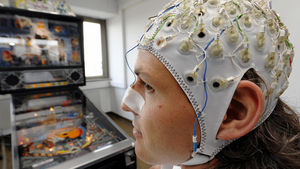Wed, 04 Aug 2010 06:27 EDT
© Agence France-Presse
Don't even consider tilting that pinny, young manReading the minds of terrorists to know where and when the next attack will occur is no longer the stuff of sci-fi films.
A team from the Northwestern University in the US claim they have achieved 100 per cent accuracy in reading the minds of make-believe terrorists simply by attaching electrodes to their scalps and examining their brain waves.
For the study, 29 students were given mock terrorist plans and 30 minutes to learn about an attack on a certain US city.
They were asked to work out their own details based on information they were given regarding weapons and methods.
For the first study, the researchers also knew about the mock terrorist plans. Their goal was to monitor whether the students' brain waves gave away details of where and when the attacks were to take place.
According to psychology professor J. Peter Rosenfeld, the "guilty" patterns occur in "P300" brain waves when meaningful information is shown to a person with "guilty knowledge".
In this case, the "terrorists" were also had to write a letter outlining their plan in order to encode the plot deeper in their memories.
They were then told to watch monitors which presented a range of stimuli, such as the names of various US cities, including the one detailed in the attack plot.
Given this prior knowledge, researchers in the test were able to correlate the rise in brain wave activity to guilty knowledge with 100 per cent accuracy across all the students that participated.
What makes the result so impressive is that in a real-life situation, the knowledge would be much more deeper entrenched, given the months or years of planning that a participant would be subject to.
But how does such technology get used to save us from another 9/11?
Such testing would be done on people picked up on the basis of activity or "chatter", psychology Prof Rosenfeld said.
The investigators would have heard prior chatter that detailed specifics such as weapons, time and place and the P300 testing would be carried out on suspects in order to determine their level of culpability and confirm the details of the attack.
Obviously, that means authorities need some prior knowledge of an attack, but a more impressive result from another test hinted at a future whereby non-suspects could be scanned for potential crimes.
In the second range of tests, researchers had no idea what they were looking for.
"Without any prior knowledge of the planned crime in our mock terrorism scenarios, we were able to identify 10 out of 12 terrorists and, among them, 20 out of 30 crime- related details," he said.
"The test was 83 per cent accurate in predicting concealed knowledge, suggesting that our complex protocol could identify future terrorist activity."

No comments:
Post a Comment